Chao-Yuan Wu
SAM 2: Segment Anything in Images and Videos
Aug 01, 2024



Abstract:We present Segment Anything Model 2 (SAM 2), a foundation model towards solving promptable visual segmentation in images and videos. We build a data engine, which improves model and data via user interaction, to collect the largest video segmentation dataset to date. Our model is a simple transformer architecture with streaming memory for real-time video processing. SAM 2 trained on our data provides strong performance across a wide range of tasks. In video segmentation, we observe better accuracy, using 3x fewer interactions than prior approaches. In image segmentation, our model is more accurate and 6x faster than the Segment Anything Model (SAM). We believe that our data, model, and insights will serve as a significant milestone for video segmentation and related perception tasks. We are releasing a version of our model, the dataset and an interactive demo.
PointInfinity: Resolution-Invariant Point Diffusion Models
Apr 04, 2024Abstract:We present PointInfinity, an efficient family of point cloud diffusion models. Our core idea is to use a transformer-based architecture with a fixed-size, resolution-invariant latent representation. This enables efficient training with low-resolution point clouds, while allowing high-resolution point clouds to be generated during inference. More importantly, we show that scaling the test-time resolution beyond the training resolution improves the fidelity of generated point clouds and surfaces. We analyze this phenomenon and draw a link to classifier-free guidance commonly used in diffusion models, demonstrating that both allow trading off fidelity and variability during inference. Experiments on CO3D show that PointInfinity can efficiently generate high-resolution point clouds (up to 131k points, 31 times more than Point-E) with state-of-the-art quality.
Reversible Vision Transformers
Feb 09, 2023Abstract:We present Reversible Vision Transformers, a memory efficient architecture design for visual recognition. By decoupling the GPU memory requirement from the depth of the model, Reversible Vision Transformers enable scaling up architectures with efficient memory usage. We adapt two popular models, namely Vision Transformer and Multiscale Vision Transformers, to reversible variants and benchmark extensively across both model sizes and tasks of image classification, object detection and video classification. Reversible Vision Transformers achieve a reduced memory footprint of up to 15.5x at roughly identical model complexity, parameters and accuracy, demonstrating the promise of reversible vision transformers as an efficient backbone for hardware resource limited training regimes. Finally, we find that the additional computational burden of recomputing activations is more than overcome for deeper models, where throughput can increase up to 2.3x over their non-reversible counterparts. Full code and trained models are available at https://github.com/facebookresearch/slowfast. A simpler, easy to understand and modify version is also available at https://github.com/karttikeya/minREV
Multiview Compressive Coding for 3D Reconstruction
Jan 19, 2023



Abstract:A central goal of visual recognition is to understand objects and scenes from a single image. 2D recognition has witnessed tremendous progress thanks to large-scale learning and general-purpose representations. Comparatively, 3D poses new challenges stemming from occlusions not depicted in the image. Prior works try to overcome these by inferring from multiple views or rely on scarce CAD models and category-specific priors which hinder scaling to novel settings. In this work, we explore single-view 3D reconstruction by learning generalizable representations inspired by advances in self-supervised learning. We introduce a simple framework that operates on 3D points of single objects or whole scenes coupled with category-agnostic large-scale training from diverse RGB-D videos. Our model, Multiview Compressive Coding (MCC), learns to compress the input appearance and geometry to predict the 3D structure by querying a 3D-aware decoder. MCC's generality and efficiency allow it to learn from large-scale and diverse data sources with strong generalization to novel objects imagined by DALL$\cdot$E 2 or captured in-the-wild with an iPhone.
MeMViT: Memory-Augmented Multiscale Vision Transformer for Efficient Long-Term Video Recognition
Jan 20, 2022



Abstract:While today's video recognition systems parse snapshots or short clips accurately, they cannot connect the dots and reason across a longer range of time yet. Most existing video architectures can only process <5 seconds of a video without hitting the computation or memory bottlenecks. In this paper, we propose a new strategy to overcome this challenge. Instead of trying to process more frames at once like most existing methods, we propose to process videos in an online fashion and cache "memory" at each iteration. Through the memory, the model can reference prior context for long-term modeling, with only a marginal cost. Based on this idea, we build MeMViT, a Memory-augmented Multiscale Vision Transformer, that has a temporal support 30x longer than existing models with only 4.5% more compute; traditional methods need >3,000% more compute to do the same. On a wide range of settings, the increased temporal support enabled by MeMViT brings large gains in recognition accuracy consistently. MeMViT obtains state-of-the-art results on the AVA, EPIC-Kitchens-100 action classification, and action anticipation datasets. Code and models will be made publicly available.
A ConvNet for the 2020s
Jan 10, 2022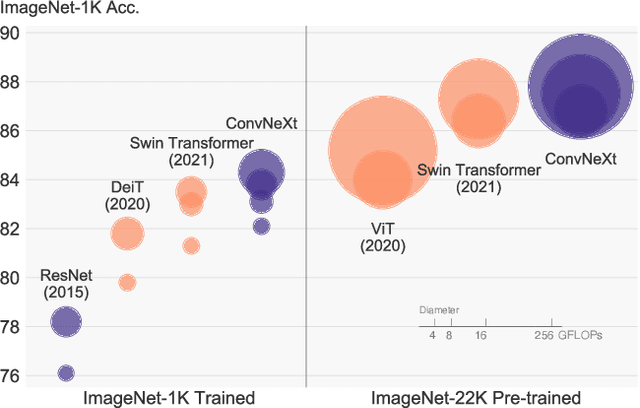
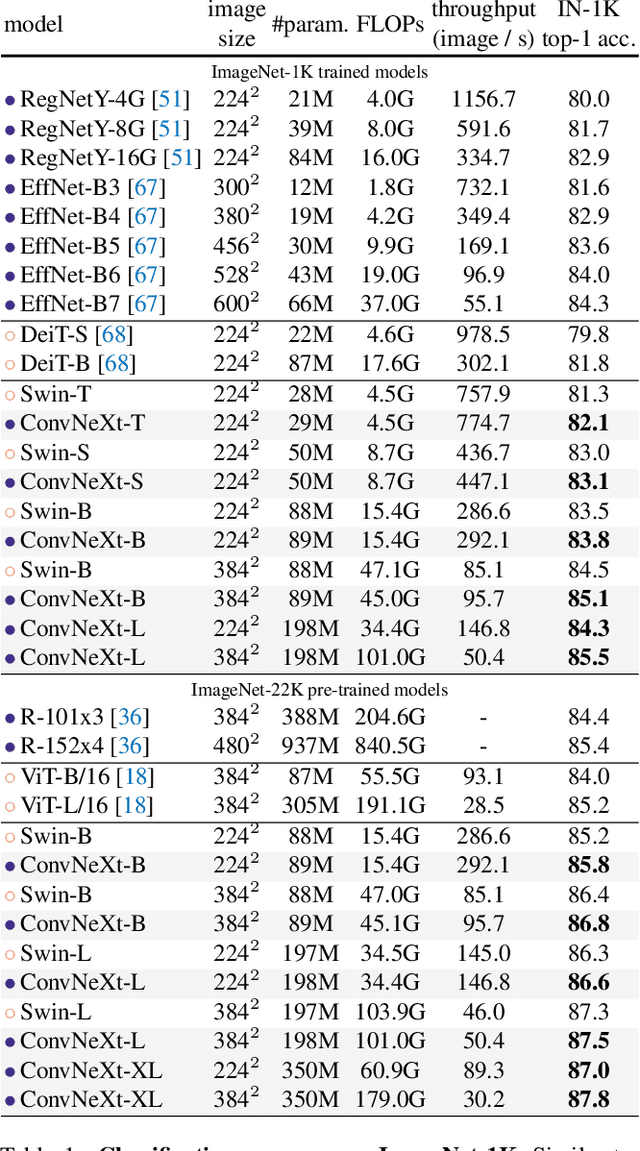
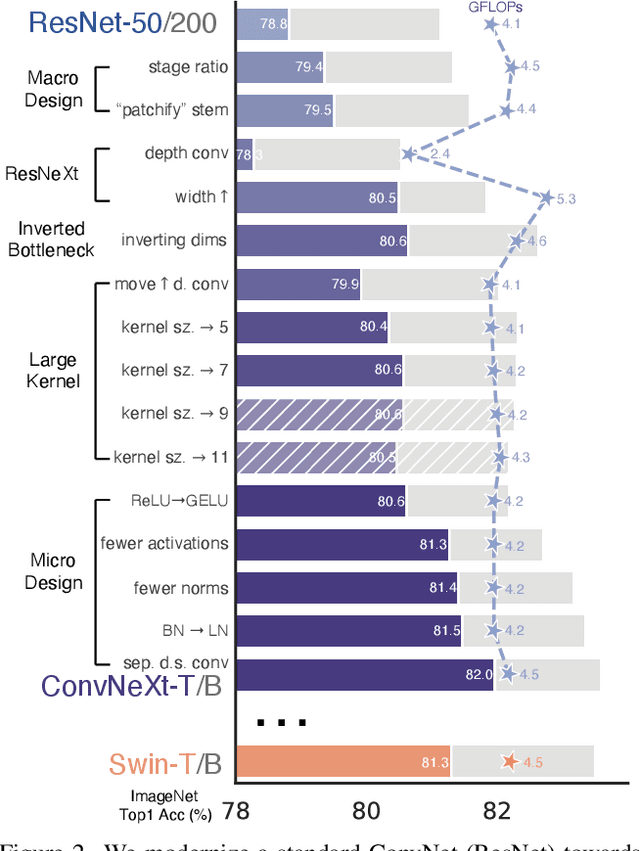
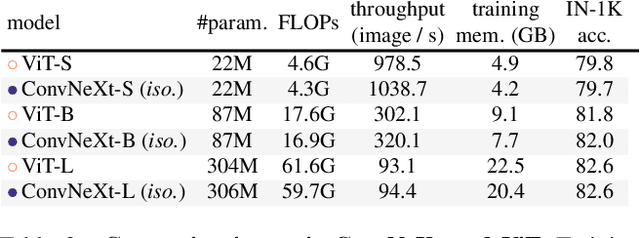
Abstract:The "Roaring 20s" of visual recognition began with the introduction of Vision Transformers (ViTs), which quickly superseded ConvNets as the state-of-the-art image classification model. A vanilla ViT, on the other hand, faces difficulties when applied to general computer vision tasks such as object detection and semantic segmentation. It is the hierarchical Transformers (e.g., Swin Transformers) that reintroduced several ConvNet priors, making Transformers practically viable as a generic vision backbone and demonstrating remarkable performance on a wide variety of vision tasks. However, the effectiveness of such hybrid approaches is still largely credited to the intrinsic superiority of Transformers, rather than the inherent inductive biases of convolutions. In this work, we reexamine the design spaces and test the limits of what a pure ConvNet can achieve. We gradually "modernize" a standard ResNet toward the design of a vision Transformer, and discover several key components that contribute to the performance difference along the way. The outcome of this exploration is a family of pure ConvNet models dubbed ConvNeXt. Constructed entirely from standard ConvNet modules, ConvNeXts compete favorably with Transformers in terms of accuracy and scalability, achieving 87.8% ImageNet top-1 accuracy and outperforming Swin Transformers on COCO detection and ADE20K segmentation, while maintaining the simplicity and efficiency of standard ConvNets.
Masked Feature Prediction for Self-Supervised Visual Pre-Training
Dec 16, 2021



Abstract:We present Masked Feature Prediction (MaskFeat) for self-supervised pre-training of video models. Our approach first randomly masks out a portion of the input sequence and then predicts the feature of the masked regions. We study five different types of features and find Histograms of Oriented Gradients (HOG), a hand-crafted feature descriptor, works particularly well in terms of both performance and efficiency. We observe that the local contrast normalization in HOG is essential for good results, which is in line with earlier work using HOG for visual recognition. Our approach can learn abundant visual knowledge and drive large-scale Transformer-based models. Without using extra model weights or supervision, MaskFeat pre-trained on unlabeled videos achieves unprecedented results of 86.7% with MViT-L on Kinetics-400, 88.3% on Kinetics-600, 80.4% on Kinetics-700, 38.8 mAP on AVA, and 75.0% on SSv2. MaskFeat further generalizes to image input, which can be interpreted as a video with a single frame and obtains competitive results on ImageNet.
Improved Multiscale Vision Transformers for Classification and Detection
Dec 02, 2021



Abstract:In this paper, we study Multiscale Vision Transformers (MViT) as a unified architecture for image and video classification, as well as object detection. We present an improved version of MViT that incorporates decomposed relative positional embeddings and residual pooling connections. We instantiate this architecture in five sizes and evaluate it for ImageNet classification, COCO detection and Kinetics video recognition where it outperforms prior work. We further compare MViTs' pooling attention to window attention mechanisms where it outperforms the latter in accuracy/compute. Without bells-and-whistles, MViT has state-of-the-art performance in 3 domains: 88.8% accuracy on ImageNet classification, 56.1 box AP on COCO object detection as well as 86.1% on Kinetics-400 video classification. Code and models will be made publicly available.
Towards Long-Form Video Understanding
Jun 21, 2021



Abstract:Our world offers a never-ending stream of visual stimuli, yet today's vision systems only accurately recognize patterns within a few seconds. These systems understand the present, but fail to contextualize it in past or future events. In this paper, we study long-form video understanding. We introduce a framework for modeling long-form videos and develop evaluation protocols on large-scale datasets. We show that existing state-of-the-art short-term models are limited for long-form tasks. A novel object-centric transformer-based video recognition architecture performs significantly better on 7 diverse tasks. It also outperforms comparable state-of-the-art on the AVA dataset.
Memory Optimization for Deep Networks
Oct 29, 2020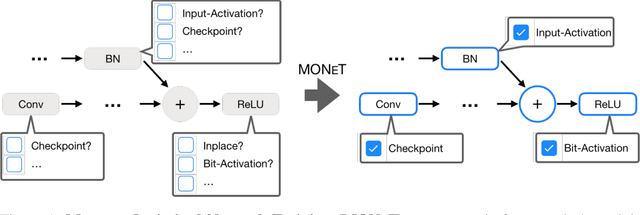

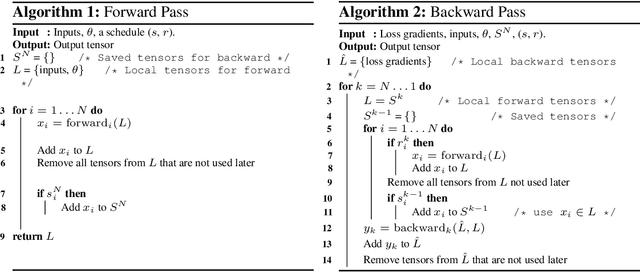

Abstract:Deep learning is slowly, but steadily, hitting a memory bottleneck. While the tensor computation in top-of-the-line GPUs increased by 32x over the last five years, the total available memory only grew by 2.5x. This prevents researchers from exploring larger architectures, as training large networks requires more memory for storing intermediate outputs. In this paper, we present MONeT, an automatic framework that minimizes both the memory footprint and computational overhead of deep networks. MONeT jointly optimizes the checkpointing schedule and the implementation of various operators. MONeT is able to outperform all prior hand-tuned operations as well as automated checkpointing. MONeT reduces the overall memory requirement by 3x for various PyTorch models, with a 9-16% overhead in computation. For the same computation cost, MONeT requires 1.2-1.8x less memory than current state-of-the-art automated checkpointing frameworks. Our code is available at https://github.com/utsaslab/MONeT.
 Add to Chrome
Add to Chrome Add to Firefox
Add to Firefox Add to Edge
Add to Edge